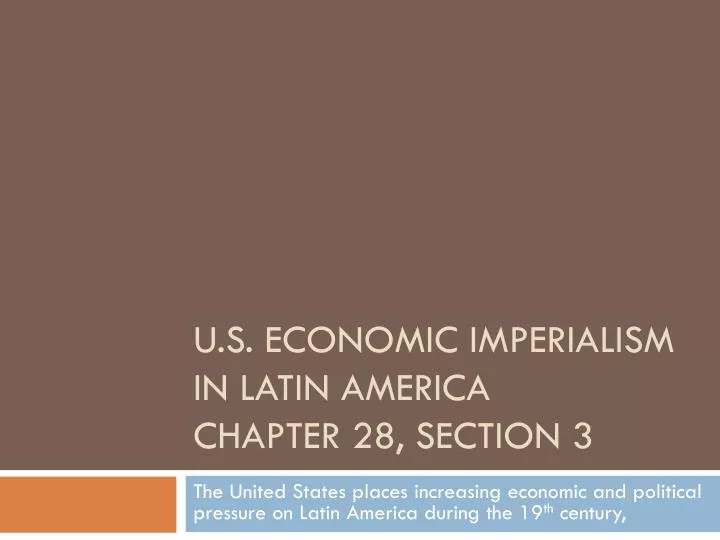Chapter 12 Section 3 Guided Reading Us Economic Imperialism
![]() Download
Download

Skip this Video
Loading SlideShow in 5 Seconds..
U.S. Economic Imperialism in Latin America Chapter 28, Section 3 PowerPoint Presentation


U.S. Economic Imperialism in Latin America Chapter 28, Section 3
Download Presentation
U.S. Economic Imperialism in Latin America Chapter 28, Section 3
- - - - - - - - - - - - - - - - - - - - - - - - - - - E N D - - - - - - - - - - - - - - - - - - - - - - - - - - -
Presentation Transcript
-
U.S. Economic Imperialism in Latin AmericaChapter 28, Section 3 The United States places increasing economic and political pressure on Latin America during the 19th century,
-
Objectives • To explain how Latin America's colonial legacy and political instability shaped its history after independence • To document how foreign powers influenced the growth of Latin American economies • To describe U.S. intervention in Latin America
-
Latin America After Independence Colonial Legacy • Political gains mean little to desperately poor Latin Americans • Peonage systems keeps peasants in debt; landowners grow wealthy Political Instability • Caudillos – military dictators – gain and hold power, backed by military • By the mid-1800s, caudillos rule in most Latin American countries • Reformers sometimes gain office, but eventually are forced out • Wealthy landowner support caudillos; poor people have few rights
-
Economies Grow Under Foreign Influence Old Products and New Markets • Economies depend on exporting one or two products • Trains and refrigeration increase demand for Latin American foods • Latin Americans import manufactured goods; industrialization lags Outside Investment and Interference • These countries build few schools, roads, hospitals • Governments forced to borrow money from other countries • Loans not repaid; properties repossessed; foreign control increases
-
A Latin American Empire The Monroe Doctrine • Newly independent countries of the Americas are insecure • In 1823, U.S. issues Monroe Doctrine – prevent European recolonization of the Americas • "the American continents… are henceforth not to be considered as subjects for future colonization by European powers"
-
A Latin American Empire Cuba Declares Independence • In 1868, Cuba declares independence, enters 10 year war with Spain and is defeated • In 1895, Jose Marti – Cuban – writer launches war for Cuban independence • U.S. fights to help Cuba in 1898, leading to Spanish-American War (economic stake) • In 1901, Cuba nominally independent; U.S. has significant control • After war, Spain gives U.S. Puerto Rico, Guam, the Philippines
-
A Latin American Empire Connecting the Oceans • US wants faster way of going from east to west coast by ship • President Roosevelt backs idea of building canal across Panama • Colombia rejects Roosevelt's $10 million canal offer • In 1903, Panama gains independence from Colombia with US help • Panama gives land to US to build canal • US builds Panama Canal – waterway connecting Atlantic and Pacific
-
A Latin American Empire The Roosevelt Corollary • US bolsters its influence in Latin America through many avenues • Many US business investments in Cuba, other countries • In 1904, Roosevelt issues update of Monroe Doctrine • Roosevelt Corollary – US can be police power in the Americas • US uses corollary to justify repeated military interventions
Chapter 12 Section 3 Guided Reading Us Economic Imperialism
Source: https://www.slideserve.com/nate/u-s-economic-imperialism-in-latin-america-chapter-28-section-3
0 Response to "Chapter 12 Section 3 Guided Reading Us Economic Imperialism"
Post a Comment